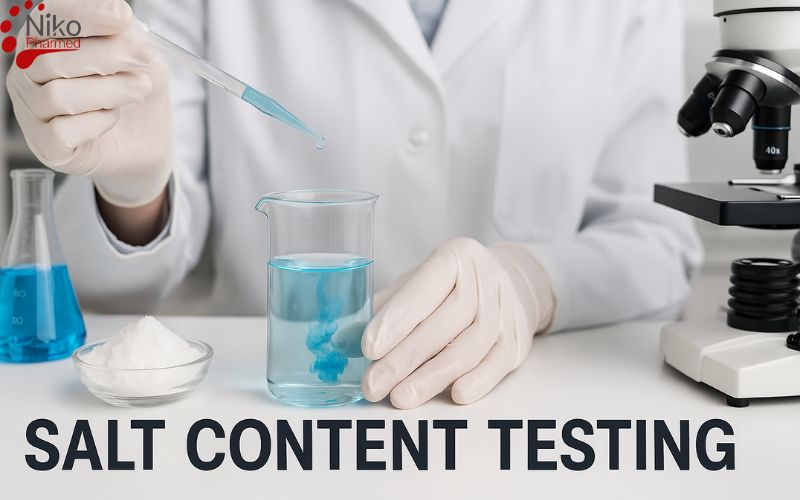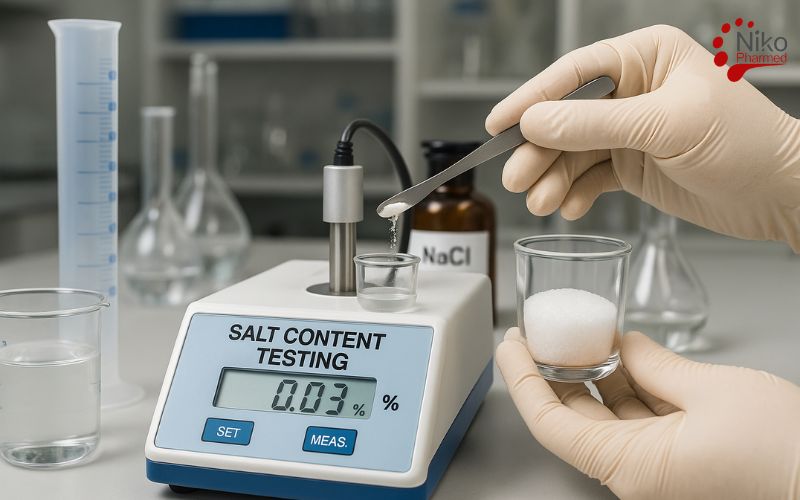What is Salt Content Testing?
Salt Content testing is the analytical determination of the concentration of soluble salts—most commonly sodium chloride (NaCl)—present in food, water, soil, or industrial products.
According to international standards such as AOAC Official Methods of Analysis, ISO 17304, and ASTM D512, this testing ensures regulatory compliance, product quality, and accuracy in nutritional labeling. Results are expressed either as a percentage by weight in solid matrices or in milligrams per liter (mg/L) for liquid samples, and procedures must follow Good Laboratory Practice (GLP) for reproducibility and accuracy.
In food, feed and nutraceutical products, salt content testing is typically analyzed with moisture content analysis as part of classical proximate analysis used for process optimization, shelf-life assessment.
Salt Content Analysis Methods
Mohr’s Method (Direct Argentometric Titration)
In Mohr’s method Chloride ions in the sample are titrated directly with a standard silver nitrate solution. Silver ions (Ag⁺) react with chloride (Cl⁻) to form a white precipitate of silver chloride (AgCl). Once all chloride is precipitated, excess Ag⁺ reacts with potassium chromate (K₂CrO₄) indicator to form a reddish-brown precipitate of silver chromate (Ag₂CrO₄), marking the endpoint.
Ag++Cl−→AgCl(s)
Endpoint:
2Ag++CrO42−→Ag2CrO4(s)(reddish brown)
Key Conditions:
pH must be near neutral (6.5–9). Acidic solutions interfere (chromate → dichromate), and alkaline solutions cause precipitation of silver hydroxide (Where pH adjustment or verification is required, these titrations are often supported by dedicated pH testing to ensure the sample remains within the optimal range for argentometric chloride determination).
Temperature should be controlled, since solubility of Ag₂CrO₄ is temperature-dependent.
Advantages:
Simple, fast, inexpensive.
AOAC and ISO recognized.
Limitations:
Requires clear, colorless solutions.
Interferences from bromide, iodide, carbonate, and phosphate ions.
Not suitable for very low chloride concentrations.
Applications:
Food industry (e.g., salt in butter, cheese, and canned foods).
Drinking water and wastewater chloride determination.
Volhard’s Method (Back Titration with Thiocyanate)
In Volhard’s method Chloride ions are precipitated with an excess of standardized AgNO₃. The remaining unreacted silver is determined by back titration with standardized thiocyanate (SCN⁻) using ferric alum (Fe³⁺) as an indicator. At the endpoint, ferric ions form a red-brown complex with thiocyanate (Fe(SCN)²⁺).
Steps:
- Chloride + Silver nitrate → AgCl (precipitate)
Ag++Cl−→AgCl(s)
- Excess Ag⁺ + SCN⁻ → AgSCN (white precipitate)
- Endpoint: Fe³⁺ + SCN⁻ → Fe(SCN)²⁺ (red-brown color)
Advantages:
Suitable for colored/turbid solutions.
More accurate for samples with interfering ions (carbonate, phosphate).
Works well even in acidic medium.
Limitations:
Requires careful control of conditions (avoid loss of SCN⁻).
More time-consuming than Mohr’s.
Applications:
AOAC validated for food samples (meat, dairy, sauces).
Used in environmental analysis when Mohr’s method is not feasible.
Potentiometric Titration (Electrochemical Endpoint)
Instead of using color indicators, a silver electrode (sensitive to Ag⁺ activity) and a reference electrode measure the potential during titration with AgNO₃. As chloride is precipitated, potential changes sharply at the equivalence point. The endpoint is detected electronically, avoiding subjective color judgment.
Advantages:
High precision and sensitivity.
Applicable to colored, turbid, or opaque samples where visual indicators fail.
Automated and suitable for routine labs.
Follows ISO 17304 and ASTM D512 standards.
Limitations:
Requires electrode maintenance and calibration.
Higher cost compared to visual titration.
Applications:
Drinking water and wastewater testing.
Industrial effluents.
Samples with color/turbidity (e.g., beverages, brines).
Ion Chromatography (IC, ISO 10304 Series)
Sample ions (Cl⁻, SO₄²⁻, NO₃⁻, etc.) are separated on an ion-exchange column and detected by a conductivity detector (with or without chemical suppression for sensitivity). The chloride peak is quantified against calibration standards.
Advantages:
High sensitivity (can detect ppb–ppm levels).
Multi-analyte detection (simultaneous chloride, nitrate, sulfate, fluoride, etc.).
Reliable, regulatory-accepted method.
Suitable for complex matrices.
Limitations:
Requires expensive instrumentation.
Sample preparation needed for high-salt or organic-rich samples.
Applications:
Environmental testing labs (surface water, groundwater, wastewater).
Soil and agricultural runoff analysis.
Regulatory monitoring of drinking water.
In regulatory water and wastewater monitoring, chloride profiles obtained by ion chromatography are typically evaluated alongside conductivity testing and heavy metals analysis to assess both ionic strength and toxic trace element contamination.
Conductivity Measurement (ASTM D1125)
Dissolved salts increase electrical conductivity. Chloride, being an ionic species, contributes significantly. However, this method does not distinguish chloride from other ions.
Advantages:
Very fast, simple, inexpensive.
No reagents or titrations needed.
Useful for process control and screening.
Limitations:
Non-specific : cannot determine chloride concentration alone.
Strongly influenced by all dissolved salts (Na⁺, Ca²⁺, sulfate, nitrate, etc.).
Not suitable for regulatory compliance where chloride must be quantified separately.
Applications:
Routine monitoring of boiler water, cooling water, and process water.
General water quality screening.
Industrial quality control (e.g., desalination plants).
Summary:
- Mohr’s → Simple, direct, visual endpoint (requires neutral pH).
- Volhard’s → Back titration, works in turbid/acidic samples.
- Potentiometric → Instrumental, precise, avoids visual bias.
- Ion Chromatography → High-tech, multi-ion, very sensitive.
- Conductivity → Quick, non-specific, screening only.
Nikopharmed Salt Content Analysis Laboratory
Laboratory Accreditation and Global Recognition
At Nikopharmed, our Salt Content Testing services are backed by ISO/IEC 17025 certification and ILAC accreditation, ensuring compliance with the highest international standards of analytical quality and technical competence.
These accreditations guarantee that our salt determinations meet the strictest global regulatory requirements and are recognized by AOAC International, ISO standards, USP, Ph. Eur., Codex Alimentarius, and leading food, beverage, water, pharmaceutical, and nutraceutical regulatory authorities worldwide.
Technical Excellence and Validated Infrastructure
Our advanced analytical facility is equipped with a comprehensive suite of methodologies for chloride and total salt determination.
We maintain precision analytical balances, automated sample handling systems, and validated extraction and clarification apparatus. This infrastructure enables us to analyze salt content in a broad range of matrices—from drinking water, processed foods, sauces, and dairy products to pharmaceutical formulations, nutritional supplements, and industrial materials.
Regulatory-Ready Reporting and Timely Results
In industries where regulatory compliance and release timelines are critical, Nikopharmed delivers rapid, accurate, and defensible salt content results.
Our optimized workflows ensure fast turnaround times without compromising analytical accuracy, reliability, or compliance—supporting quality assurance programs, product certification, import/export inspections, and label claim verification.
Confidentiality and Data Integrity
We uphold the highest standards of client confidentiality and data security. All salt content testing is conducted under strict non-disclosure agreements and supported by 21 CFR Part 11-compliant electronic data systems. Every analysis includes a complete audit trail, ensuring traceability, reliability, and integrity of results. Proprietary formulations, research data, and regulatory submissions are handled with uncompromising ethical and professional standards.
Competitive Pricing with Uncompromised Quality
We provide cost-effective salt analysis solutions tailored to the needs of small enterprises, multinational corporations, and regulatory authorities. Our transparent pricing structure enables clients to achieve compliance efficiently while maintaining the highest analytical standards, reducing approval timelines without compromising data quality or credibility.
To request testing or a complimentary consultation contact Nikopharmad
Partner with Nikopharmed for Expert Salt Content Testing
By partnering with Nikopharmed, you gain access to a globally accredited laboratory dedicated to scientific excellence, regulatory compliance, and data confidentiality. Whether ensuring product consistency, verifying label claims, meeting import/export regulations, or complying with strict industry standards, our salt content Analysis expertise guarantees accurate, reliable, and internationally recognized results—helping you achieve compliance with complete confidence.


